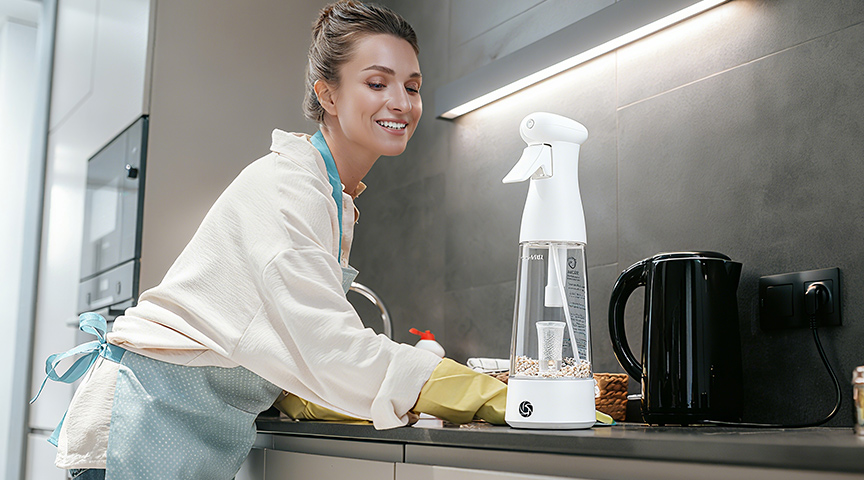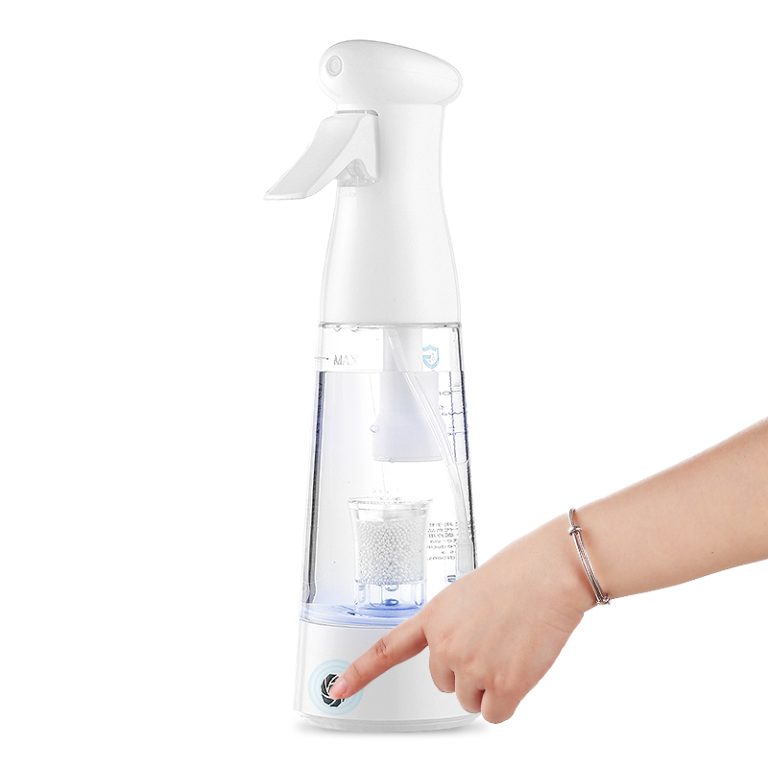Cutting Boards: Dual Threats of E. coli & Salmonella
1. Detected: Escherichia coli (E. coli) , Salmonella (University of Arizona, 2018) 2. How to disinfect cutting boards safely starts with understanding the risks:✅ They accumulate 200 CFU/cm² of E. coli within 2 hours—matching toilet seat contamination levels (University of Arizona, 2018).
✅ Wooden vs plastic cutting board hygiene: Studies show wooden boards promote 300% faster E. coli growth when stored horizontally (Journal of Food Protection, 2021)
✅ Within just 6 hours, E. coli can form antibiotic-resistant biofilms. Studies show this increases bacterial resistance by up to 1000 times (Biofouling, 2023).
✅ Raw poultry and eggs are the main reservoirs of Salmonella, with contamination rates of 25-40% on cutting boards after processing these ingredients (CDC, 2023).
✅ Salmonella can persist for >48 hours in knife grooves of wooden cutting boards (Applied and Environmental Microbiology, 2022).
✅ Bacterial doubling time: 20-30 minutes at room temperature (FDA, 2022)
✅ 60% relative humidity → bacterial division rate increases by 2 times (Applied and Environmental Microbiology, 2022)
✅ Knife grooves on cutting boards trap water, creating microenvironments with up to 90% humidity. This accelerates bacterial growth (Applied and Environmental Microbiology, 2022).
3. Risks: Food contamination → Diarrhea, UTIs 4. 3 Proven Disinfection Methods to reduce bacteria on cutting boards| METHOD | PROCEDURE | REDUCE RATE | PROS. | CONS. | BEST FOR |
| Vinegar | 1:1 vinegar spray, wait 5 mins | 85% | Non-toxic, accessible | Weak against biofilms | Wood/plastic |
| Hydrogen Peroxide | Soak in 3% solution for 10 mins (ventilated), rinse | 99% | Penetrates biofilms | Strong odor, may bleach plastic | Plastic/glass |
| Bleach | 1 tbsp bleach + 1L water, wipe 1 min., rinse | 99.9% | Fast & cheap | Corrodes wood, harsh fumes | Plastic (avoid wood) |
Sponges & Dishcloths: 200,000x Dirtier Than Toilets
1. Detected: coli, Salmonell, Staphylococcus aureus (NSF International, 2021) 2. Real-World Data✅ NSF International (2022): 75% of kitchen sponges tested positive for coliform bacteria (indicating fecal contamination, incl. E. coli).
✅ CDC (2018): ~12% of foodborne infections linked to contaminated kitchen surfaces, including dishcloths.
✅ CDC (2023): Salmonella detected on 25-40% of kitchen surfaces (incl. cutting boards and dishcloths) after raw poultry handling.
✅ Journal of Hospital Infection (2021): Hospital studies show 40% MRSA transfer risk from contaminated fabrics; household cloths likely similar.
3. Why Do Sponges &Dishcloths Smell Bad? Science Reveals: Bacterial Waste is the Culprit!✅ Bacteriasdevelop antibiotic-resistant biofilms within hours.
✅ MRSA survived 8+ hours on damp cloths under laboratory conditions (>80% humidity).(J. Appl. Microbiol., 2022)
✅ Coli persists for 48 hours on damp cloths(>80% humidity, 22°C).(Appl. Environ. Microbiol., 2022).
✅ Salmonella can survive for over 72 hours in fabric fibers. This persistence is due to the protection provided by bacterial biofilms (Biofouling, 2023).
✅ How often should I replace my kitchen sponge? NSF International data(2022)shows “sponges harbor 10⁷ CFU/cm³ of S. aureus – 200,000x dirtier than toilet seat.” Replace them weekly, or immediately if odors develop.
4. Risks: Skin infections, food poisoning 5. How to Clean Kitchen Sponges & DishclothsA. Daily Cleaning (Quick Disinfection)
✅ Microwave Method (Best for sponges): Wet the sponge, microwave on high for 1 minute (reduce99% bacteria) . Avoid if sponge has metal scrubbers.
✅ Boiling Water (Best for cloths): Submerge in rolling boil for 5 minutes, effective against MRSA & Salmonella.
B. Weekly Deep Cleaning
✅ Bleach Soak (For tough biofilms): Mix 1 tbsp bleach + 1L water, soak sponge/cloth for 5 minutes, then rinse thoroughly.
✅ Hydrogen Peroxide (Color-safe alternative): Use 3% solution, soak for 10 minutes.
Why Argentumix Silver Ion Generator A Smarter Option?
1. Triple-Action Protection Against Kitchen Bacteria✅ Breaks Down Bacteria: Silver ions penetrate bacterial walls like tiny spears, bursting harmful cells apart just like popping balloons.
✅ Cuts Off Energy Supply: Disrupts the power source bacteria need to multiply, effectively starving them to death.
✅ Long-Lasting Protection: Keeps treated surfaces protected for up to 24 hours, preventing regrowth between cleanings.
2. Powerful Yet Gentle Kitchen Protection✅ Studies indicate that at concentrations of 1 ppm, silver ions can penetrate specific bacterial biofilms 2 to 3 times more effectively than 200 ppm bleach solutions (Biofouling, 2023; ACS Applied Materials & Interfaces, 2021).
✅ No harsh fumes: Unlike bleach or chlorine-based cleaners, Argentumix leaves no chemical odor—ideal for food prep areas and enclosed spaces.
✅ Skin-friendly: Low-concentration silver ions (1–3 ppm) are non-irritating to skin, even with frequent use (no gloves required).
✅ Safe around food: No toxic residues, making it perfect for countertops, cutting boards, and appliances.
Electrolytic Silver Ions vs. Nano Silver: Which Technology Wins for Home Kitchens?
Science-Backed Comparison for Your Disinfection Needs| Feature | Electrolytic Silver Ions | Nano Silver Ions |
| Production Method | Real-time electrolysis (Ag⁺ generated on-demand) | Industrially pre-made solutions |
| Bacterial Reduction | 99% in 10 minutes (Biofouling, 2023) | 90% in 30 minutes (slow release) |
| Biofilm Penetration | 2-3× deeper than bleach (ACS Applied Materials, 2021) | Limited by stabilizers (e.g., PVP) |
| Chemical Additives | None (pure Ag⁺ + water) | Carrier agents required |
| Food Safety | FDA-compliant (Notification No. 1789) | Not recommended for direct contact |
| Best Use Cases | Daily disinfection, food prep surfaces | Long-term antimicrobial coatings |

How to Use Argentumix Safely & Effectively
1. Designed for Home Hygiene✅ Perfect for homes with kids & pets—effective without harsh chemicals.
✅ Preventative disinfection: Reduces risks of cross-contamination from raw foods (e.g., poultry, eggs).
✅ Argentumix generates low-concentration silver ions (1-3ppm) — ideal for daily home hygiene. Note: This solution is designed for reducingmicrobial contamination on household surfaces. Not for medical use.
2. How to use:✅ Fill with purified water, electrolyze for 10 mins to get 1-2ppm silver ion solution.
✅ Soak cutting boards/sponges/cloths for 10-30mins → rinse.
✅ The soaking time depends on the level of bacterial risk and solution concentration. Generally, a 0.5ppm solution can act on Escherichia coli within 10 minutes.
3. What you may be concerned about✅ For Tableware & Food-Contact Surfaces:
Rinse thoroughly with potable water twice (minimum 30 seconds per rinse) before reuse.
Scientific basis: Reduces residual silver ions to <0.01 mg/cm² (FDA Food Contact Substance Notification No. 1789).
✅ For Residual Solution Disposal:
Small volumes (<1L/day): May discharge directly (EU ECHA guidance for solutions <5 mg/L Ag⁺).
Large volumes: Dilute 1:10 with water to achieve <0.5 mg/L before draining. (WHO mercury limit for drinking <0.1mg/L)
✅ Ready to use, use within 24 hours, avoid long-term storage.
Your family’s health demands more than surface cleaning. Let’s begin where the dangers do. Protect Your Home. Support a Cleaner Lifestyle. Explore Our Antimicrobial Solutions → Independent lab tests confirm 99.8% reduction of E. coli and Staph. [DOWNLOAD FULL REPORT] [LEARN MICROBE ENCYCLOPEDIA] [EXPLORE WHERE TO USE]


